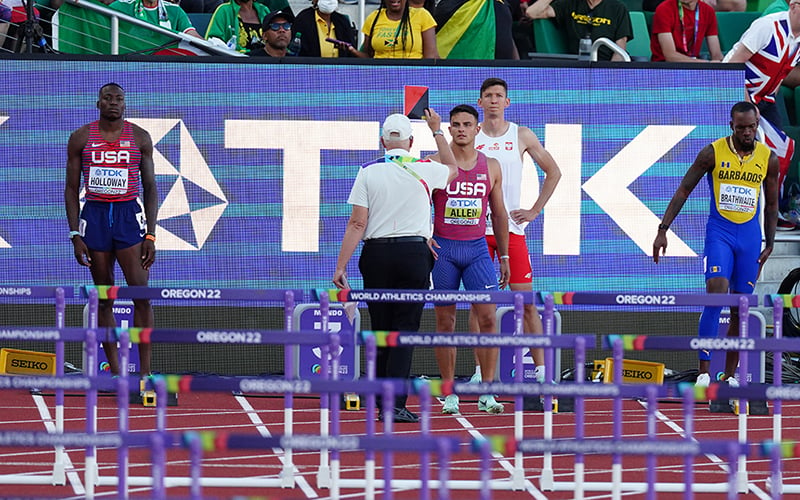A new normal
Houlihan’s life today includes strong family and friend support.
Cranny said she had a lot of conversations with BTC teammates to make sure Houlihan felt supported.
“What you initially think of is her mental health and someone’s life being completely ripped out from under them and not being able to do what you love to do and what she feels like she’s been born and made to do,” Cranny said. “In the beginning, you worry about her being by herself, and making sure that she has people around her and she feels supported.”
Shelby’s mother, Connie Houlihan, who lives in Phoenix, said she is worried about the mental toll on her daughter.
“You’re afraid of suicide,” Connie Houlihan said. “You know, everything’s a possibility … with depression and with something that critical that they took away from her. You don’t know. Of course, you’re scared to death.”
Connie said a couple of Shelby’s sisters went to be with Shelby right away because they didn’t want her alone. Shelby wouldn’t let her parents come visit, however, because, Connie said, “she was so overcome.”
“I think, if we would have flown there right away, she would have … this is the way she explained it to me, ‘That it would have made it all too real.’
“She was really struggling dealing with it,” Connie said. “She was crying all the time. But I think that was the hardest part for us that we couldn’t just jump on a plane and go and be with her because we respected her decision.”
Chloe Houlihan, one of Shelby’s five sisters, said her sister remained “very resilient through everything.” She said she has tried to be someone Shelby “can talk to when she’s kind of struggling.”
Shelby no longer trains with her BTC teammates, something which Chloe said has been difficult and “a little bit isolating” for her sister.
Until May, Houlihan was paying Schumacher to coach her as an independent athlete, but she confirmed she’s now training entirely by herself – using six years of past training logs as a reference.
“We just felt it was best to maybe cut ties for a little bit,” Houlihan said. “I think there was just a lot of publicity going on around me and him still working together. There was just a lot of scrutiny, I think.”
Some of that publicity and scrutiny was fueled by DeBues-Stafford’s decision to leave BTC because of Houlihan.
A two-time Canadian Olympian who placed fifth in the 1,500 at the Tokyo Olympics, DeBues-Stafford announced in April she left BTC due to Houlihan’s continued ban involvement with BTC at the time.
“Fundamentally, I left the Bowerman Track Club because, despite my best efforts, I was unable to verify that the club was not in violation of World Athletics anti-doping regulations,” DeBues-Stafford said in an interview conducted via email.
DeBues-Stafford was concerned that Houlihan was working out “under the guidance of” the three BTC coaches (Schumacher, Shalane Flanagan and Pascal Dobert) at the same location and times that other BTC athletes were working out while under the supervision of the same coaches.
“While we never did a rep together, there was still what felt to me like an unnecessarily risky proximity between both men’s and women’s teams and an athlete serving a ban,” DeBues-Stafford said.
According to DeBues-Stafford, Houlihan would also use the private gym – built at Schumacher’s residence for BTC athletes to use – at the same time BTC athletes were there under staff supervision.
“Shelby would drive to the Nike campus up to four times a week at the team’s regular time and the starting point for our regular daily runs together so she could run with us,” DeBues-Stafford said. “If she arrived before us, she would wait for BTC athletes at the meeting spot to see if any BTC athletes arrived so she could run with us. These sometimes included long runs. She also ran with the team on a regular basis at altitude camp in Flagstaff.”
Houlihan said she and her attorney inquired about the rules of her ban and were told that she couldn’t go to any practices or work out with anyone on the team, but if she happened to bump into them and they were running at the same place, then she could run with them.
“My attempts to discuss my concerns with team staff were rebuffed, as were the earlier and more sustained efforts of other teammates,” DeBues-Stafford said.
BTC did not receive independent legal advice on the issue, DeBues-Stafford said. She also said Houlihan shared accommodations with a full-time member of BTC staff during the Flagstaff camp, and those accommodations were used for organized BTC athlete support activities.
“When I asked if Shelby’s lawyer had explicitly asked the AIU about her using the same gym as BTC and about how to handle the altitude trip, I did not get a clear response,” DeBues-Stafford said.
DeBues-Stafford said she “independently sought answers,” and reached out to an anti-doping organization to verify that BTC’s collective behavior was within the rules and that there was no liability on anyone other than Houlihan.
According to DeBues-Stafford, “the anti-doping organization could not guarantee that the actions of BTC and Shelby did not constitute a violation, and could not guarantee that other athletes and support staff couldn’t face repercussions either.”
She said the anti-doping agency cited two rules in the World Anti-Doping code and advised her to leave BTC and submit an official anonymous tip to the AIU.
A trying time
While Schumacher and some of Houlihan’s other teammates knew about her positive test in January of 2021, DeBues-Stafford did not learn about Houlihan’s positive test until a couple of days before the team publicly announced the ban about six months later.
“Learning this news in mid-June almost derailed my Olympics,” DeBues-Stafford wrote in an Instagram post in April. “It was a small miracle that I showed up in Tokyo in shape to run sub-four (minutes) twice in 48 hours and place fifth.”
Houlihan said she was “surprised” and felt “blindsided and hurt and confused” by DeBues-Stafford’s social media posts because DeBues-Stafford had not told her about her concerns.
“I never knew that that was a problem for her,” Houlihan said. “And I’m not sure why she didn’t reach out to me. I reached out to her after I read her posts.”
Houlihan said she apologized to DeBues-Stafford for being affected by her situation.
“I think she just felt like she didn’t want to add to what I was going through by bringing it to me, which I don’t agree with, personally,” Houlihan said. “I felt like I would have rather had that conversation with her and I would have been more than glad to try to help that situation for her in any way, instead of what ended up happening. I think that was a lot worse – what ended up happening – than her just coming and talking to me about it.”
DeBues-Stafford has since moved to Victoria, B.C. and is now coached by Trent and Hilary Stellingwerff.
“When I told Jerry (Schumacher) I was leaving BTC due to the lack of separation between Shelby and the group, he asked if I really wanted to leave, given he was thinking of possibly no longer coaching Shelby if she lost her appeal at the Swiss Federal Tribunal,” Debues-Stafford said.
Debues-Stafford said Houlihan was still driving to the Nike campus and running with BTC when Debues-Stafford left Portland on March 31.
“Growing fear over the team potentially breaking rules, coupled with frustration at the lack of action by the team left me in an awful and unsustainable headspace,” DeBues-Stafford said. “I left altitude camp early at the end of February to get some breathing space and made my decision to leave the team.”







